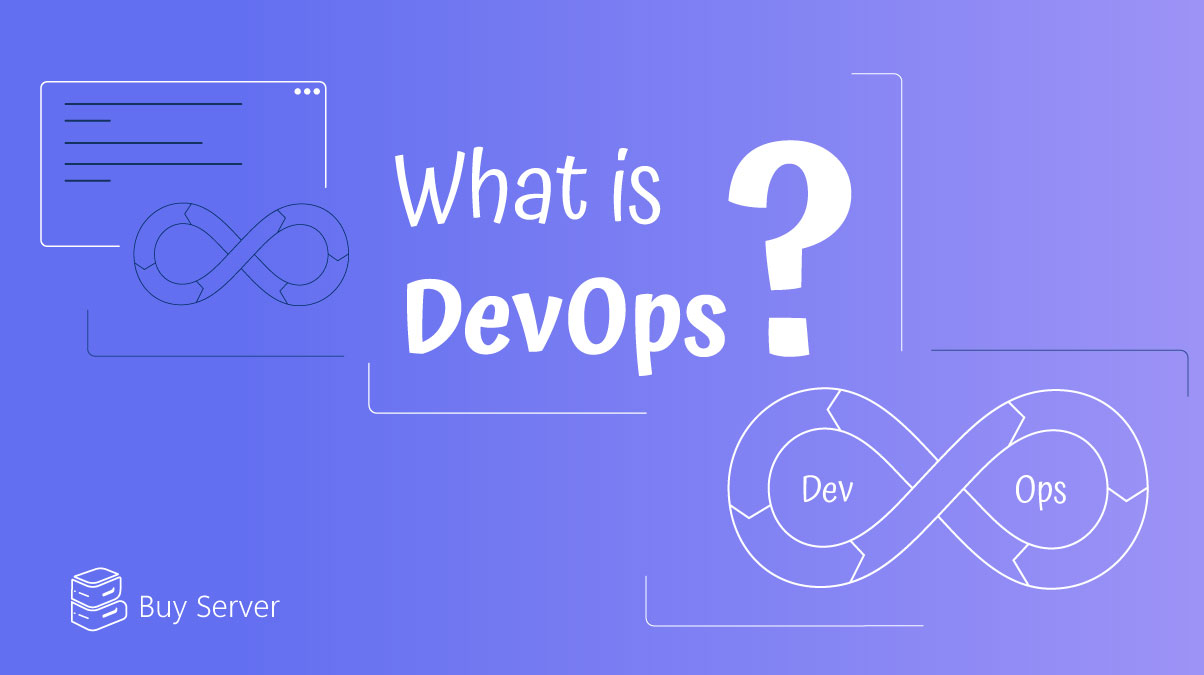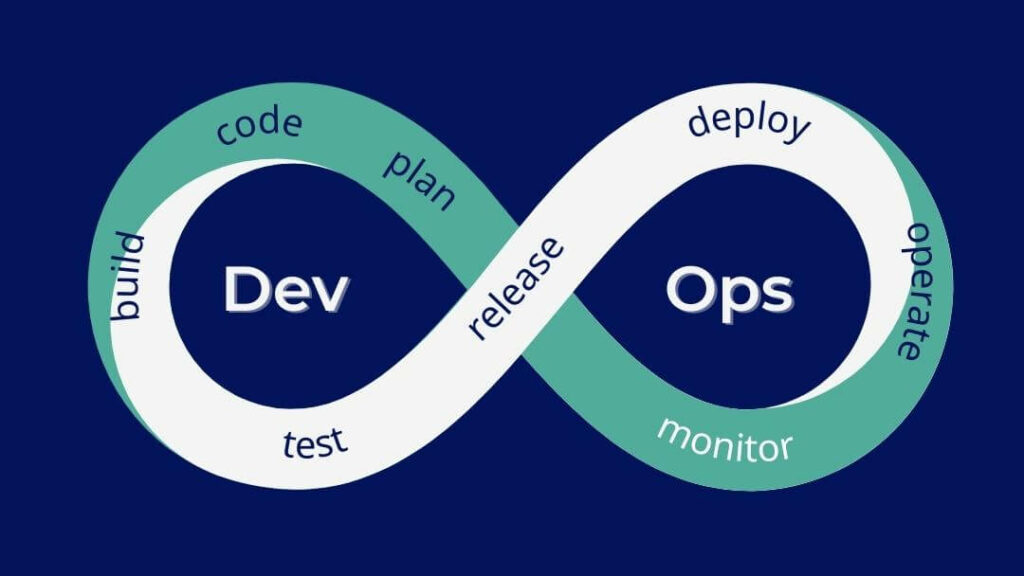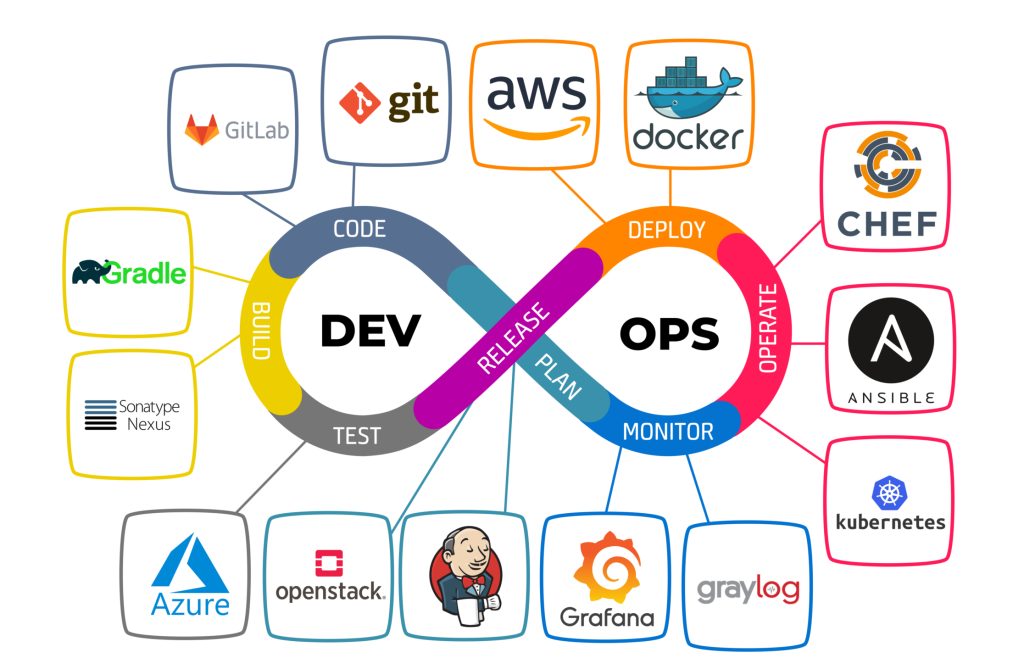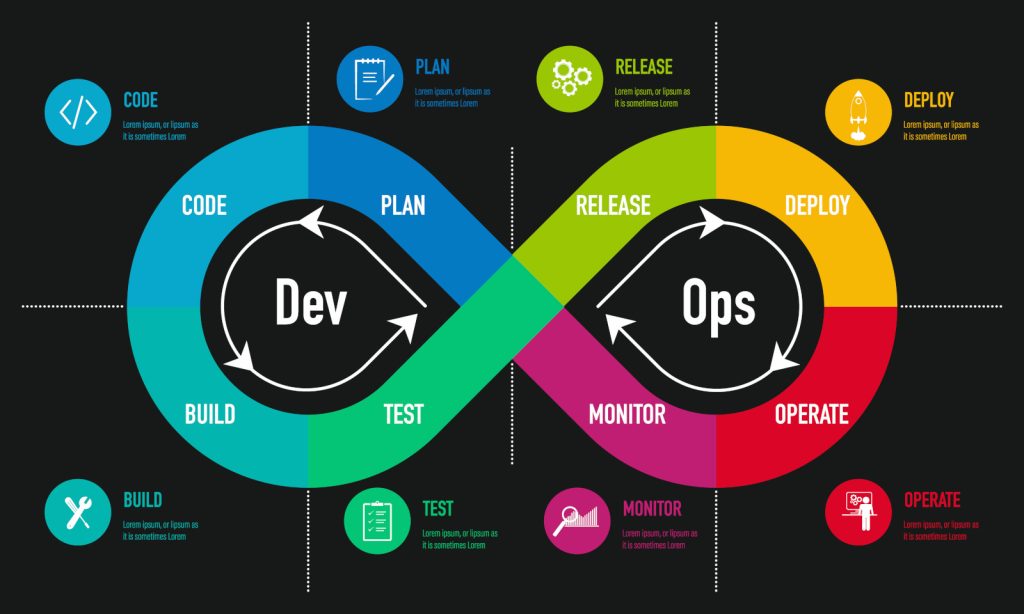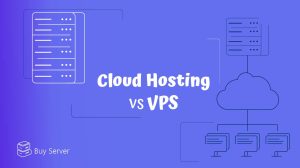Understanding DevOps is crucial for anyone wanting to bridge the gap between development and operations, creating a culture of collaboration and automation. In this article, we’ll explore what DevOps is, how it works, the key tools involved, and the many benefits it offers.
By diving into this transformative approach, you’ll see how DevOps can revolutionize the way you deliver software. It can make your process faster, more reliable, and ultimately give your business a competitive edge.
Join us as we explore the principles, practices, and advantages of DevOps, and discover how it can drive success in your organization.
What is DevOps?
DevOps is a set of practices, tools, and a cultural philosophy designed to bridge the gap between software development and IT operations. It focuses on automating and integrating processes, with a strong emphasis on team empowerment, cross-team communication, collaboration, and technology automation.
The DevOps movement began around 2007 in response to the traditional software development model’s challenges, where developers and operations teams often worked in silos.
By combining development (Dev) and operations (Ops), DevOps helps organizations deliver applications and services more quickly, boosting efficiency, speed, and security.
This agile approach to the software development lifecycle provides a significant competitive advantage. In essence, DevOps is a transformative methodology that enables faster product evolution and better customer service.
What DevOps means?
DevOps involves integrating development (Dev) and operations (Ops) to enhance the efficiency, speed, and security of software development and delivery.
This approach streamlines the software development lifecycle, making it more agile and responsive. By breaking down the barriers between development and operations, DevOps enables faster and more reliable software releases, giving businesses a competitive edge.
DevOps focuses on continuous improvement, automation, and collaboration, ensuring that software products are developed and delivered with higher quality and greater efficiency than traditional methods.
In essence, DevOps fosters a culture of seamless integration and constant innovation.
How does DevOps work?
DevOps works by eliminating the traditional silos between development and operations teams, merging them into a single, cohesive unit.
Engineers in a DevOps team collaborate across the entire application lifecycle, from development and testing to deployment and operations, cultivating a diverse skill set.
This integrated approach often also includes quality assurance and security, leading to the concept of DevSecOps, where security is embedded throughout the development process.
DevOps for software engineering relies heavily on automation. Teams utilize a technology stack and toolchain to streamline historically manual and slow processes. These tools enable tasks like code deployment and infrastructure provisioning to be completed independently by engineers, boosting team velocity and reliability.
Ultimately, DevOps fosters a cultural shift that emphasizes collaboration, continuous integration, and continuous delivery, enhancing both the speed and quality of software deployment.
What are DevOps tools?
DevOps tools play a crucial role in supporting the various stages of the DevOps lifecycle. They help improve collaboration, automate processes, and provide essential monitoring and observability. Here are some key DevOps tools and practices explained in detail:
-
Version Control
Tracks and manages every change made to source code and other files, ensuring that all modifications are documented and can be reverted if necessary. It is closely related to source code management and is fundamental for collaborative development.
-
Agile Development
Utilizes iterative, incremental, and lean approaches to streamline and accelerate the delivery of projects. It fosters flexibility and rapid adaptation to changes, enhancing the efficiency of the development process.
-
Continuous Integration (CI)
Regularly integrates all code changes into the main branch, automatically testing each change to ensure it doesn’t break the build. This practice helps detect and fix issues early, improving code quality.
-
Continuous Delivery (CD)
Works in conjunction with continuous integration to automate infrastructure provisioning and the application release process. This ensures that software can be released reliably and frequently, speeding up the deployment process.
-
Shift Left
Emphasizes integrating security and testing earlier in the development process. This approach helps to speed up development while simultaneously improving code quality by identifying issues earlier.
Each of these tools and practices contributes to the efficiency and effectiveness of DevOps, enabling teams to deliver high-quality software quickly and reliably.
8 key benefits of DevOps
DevOps offers numerous advantages that enhance the efficiency, speed, and security of software development and delivery. Here are some key benefits of DevOps and how they contribute to improved organizational performance:
-
Speed
DevOps enables organizations to move at high velocity, allowing them to innovate faster, adapt to changing markets, and improve business results. Practices like microservices and continuous delivery help teams release updates quickly and efficiently.
-
Rapid Delivery
By increasing the frequency and pace of releases, DevOps teams can innovate and enhance their products faster. Continuous integration and continuous delivery automate the software release process, ensuring new features and bug fixes reach customers swiftly.
-
Improved Collaboration
DevOps fosters a culture of collaboration between development and operations teams. By sharing responsibilities and combining workflows, teams become more efficient and reduce time lost to handoffs, leading to faster and more reliable releases.
-
Quality and Reliability
DevOps practices such as continuous integration and continuous delivery ensure that changes are tested and safe, improving the overall quality of the software product. Real-time monitoring keeps teams informed about performance, enhancing reliability.
-
Security
Integrating security into the development process, known as DevSecOps, ensures that security measures are active and continuous. Automated compliance policies and fine-grained controls help maintain security without compromising speed.
-
Scale
DevOps enables organizations to operate and manage infrastructure and development processes at scale. Automation and consistency reduce the risk of managing complex systems, and practices like infrastructure as code make managing environments more efficient and repeatable.
-
Fluid Responsiveness
Enhanced collaboration under DevOps leads to real-time feedback and greater efficiency. Teams can implement changes and improvements quickly, removing guesswork and speeding up development cycles.
-
Shorter Cycle Time
Increased efficiency and frequent communication between teams result in shorter cycle times. This means new code can be released more rapidly while maintaining high standards of quality and security.
DevOps methodology
The DevOps methodology focuses on streamlining the development and deployment processes to achieve continuous delivery of high-quality software.
It centers around fostering collaboration, enhancing automation, integrating processes, and implementing rapid feedback cycles, ensuring a culture of reliability and efficiency in software development.
Key principles of the DevOps methodology include:
-
Automation
Automating various stages of the software development lifecycle, such as testing, building, releasing, and provisioning development environments, reduces manual errors and accelerates the delivery process.
-
Collaboration and Communication
Effective teamwork and open communication channels are crucial. DevOps teams work closely together, sharing responsibilities and ensuring everyone is on the same page.
-
Continuous Improvement
DevOps encourages teams to constantly seek ways to optimize processes, eliminate waste, and enhance performance. This involves automating repetitive tasks and using metrics to identify areas for improvement.
-
User-Centric Focus with Quick Feedback
DevOps teams prioritize user needs by maintaining short feedback loops. This allows them to quickly adapt and deliver features and fixes that provide real value to users.
By adhering to these principles, organizations can improve software quality, accelerate time to market, and develop better application strategies, ultimately resulting in more effective and responsive software solutions.
This revised version maintains the original content’s clarity and thoroughness while ensuring consistency and readability.
DevOps practices
DevOps practices streamline software development and deployment by enhancing collaboration, automation, and efficiency. Here are key practices that drive successful DevOps implementation:
- Continuous Integration
Developers frequently merge their code changes into a shared repository. Automated builds and tests are run to identify and resolve bugs quickly, improving software quality and accelerating the validation and release of new updates.
- Continuous Delivery
Building on continuous integration, this practice automates the testing and preparation of code changes for production release. It ensures that every code change is deployment-ready, having passed through rigorous standardized tests.
- Microservices
An architectural style that structures an application as a collection of small, independently deployable services. Each service is designed around specific business capabilities and communicates with other services via lightweight APIs, allowing for flexible and scalable development.
- Infrastructure as Code
This approach treats infrastructure management using the same principles as software development, such as version control and continuous integration. It enables developers to provision and manage infrastructure programmatically, ensuring consistency, scalability, and repeatability.
- Monitoring and Logging
Essential for maintaining system health and performance, monitoring and logging provide real-time insights into application and infrastructure status. These practices help teams detect issues early and respond swiftly, ensuring high availability and reliability.
- Communication and Collaboration
DevOps emphasizes a culture of open communication and collaboration between development and operations teams. By breaking down silos and encouraging teamwork, organizations can achieve more efficient workflows and better alignment with business objectives.
These DevOps practices collectively enhance the efficiency, reliability, and speed of software development and deployment, fostering a more agile and responsive development environment.
How to Adopt DevOps?
Adopting DevOps is a transformative process that requires a commitment to cultural change, process improvement, and the implementation of new tools and practices.
Here’s a step-by-step guide to help you successfully adopt DevOps:
- Embrace a DevOps Culture
Transitioning to DevOps starts with fostering a culture of collaboration and communication between development and operations teams. Break down the silos that traditionally separate these teams and encourage a unified approach where both work together towards common goals. This involves:
– Encouraging frequent communication and collaboration.
– Aligning teams around customer-centric objectives.
– Promoting accountability across the entire product lifecycle.
- Continuous Learning and Experimentation
Organizations that excel in DevOps create an environment where experimentation and risk-taking are encouraged. This means:
– Fostering a mindset that views failure as a learning opportunity.
– Encouraging innovation and creative problem-solving.
– Continuously seeking ways to improve processes and outcomes.
- Implement Agile Methodologies
Agile methodologies complement DevOps by promoting flexibility, organization, and responsiveness to change. When integrated with DevOps, agile practices enhance efficiency and reliability. Key steps include:
– Adopting iterative development cycles.
– Facilitating regular feedback loops.
– Empowering teams to adapt quickly to new information and requirements.
- Automate Processes
Automation is at the heart of DevOps, reducing manual errors and accelerating delivery. Focus on:
– Automating repetitive tasks like testing, building, and deploying code.
– Using tools that support continuous integration (CI) and continuous delivery (CD) to ensure rapid and reliable software releases.
– Implementing infrastructure as code (IaC) to manage and provision computing resources programmatically.
- Adopt Microservices Architecture
Microservices architecture breaks down complex applications into smaller, independent services. This approach:
– Enhances the flexibility and scalability of applications.
– Allows teams to develop, deploy, and scale services independently.
– Reduces the complexity of coordinating updates across large systems.
- Enhance Monitoring and Logging
Effective monitoring and logging are essential for maintaining system health and performance. Implement tools and practices that:
– Provide real-time insights into application and infrastructure performance.
– Enable rapid detection and resolution of issues.
– Support proactive maintenance and optimization.
- Foster Continuous Improvement
DevOps is an ongoing journey of improvement. Encourage your teams to:
– Regularly review and refine their processes.
– Use metrics and feedback to identify areas for enhancement.
– Stay informed about new tools, technologies, and best practices in the DevOps space.
By following these steps, your organization can successfully adopt DevOps, resulting in faster, more reliable software delivery and a stronger alignment between development and operations teams.
What is DevOps engineering?
DevOps engineering is a multifaceted role that involves overseeing the entire software development lifecycle, ensuring seamless integration of development processes, and promoting a culture of collaboration and efficiency.
A DevOps engineer is responsible for automating workflows, managing software releases, and maintaining IT infrastructure. They play a critical role in bridging the gap between development and operations teams by implementing DevOps methodologies and principles.
Key responsibilities of a DevOps engineer include:
– Release Engineering
Building and deploying application code using continuous integration and continuous deployment (CI/CD) tools. This may involve selecting, provisioning, and maintaining these tools or creating custom build and deploy scripts.
– Infrastructure Provisioning and System Administration
Deploying and managing servers, storage, and networking resources. This can include managing physical infrastructure for on-premise resources or virtual instances for cloud-based environments.
– Automation
Introducing automation wherever possible to reduce manual tasks and human error. This includes automating testing, builds, releases, and environment provisioning.
– Collaboration and Communication
Facilitating effective communication between development and operations teams, and ensuring alignment with business goals and customer needs.
– Continuous Improvement
Regularly evaluating processes and tools to identify areas for improvement, reducing waste, and enhancing performance.
– DevOps Advocacy
Promoting the DevOps culture within the organization, educating team members about DevOps practices, and advocating for their adoption.
DevOps engineers need a broad range of skills, including knowledge of programming languages, system architecture, and infrastructure management.
They must also possess strong communication and interpersonal skills to collaborate effectively across teams and drive organizational change. By focusing on these areas, DevOps engineers help organizations deliver high-quality software more quickly and efficiently.
The Final words
In summary, this article has delved into the core aspects of DevOps, explaining what it means, how it operates, and the essential tools and practices involved.
We have explored the significant benefits of adopting DevOps, such as increased speed, improved collaboration, enhanced security, and greater efficiency in software development and delivery.
By understanding and implementing DevOps principles, organizations can achieve faster product evolution and provide better customer service, ultimately gaining a competitive advantage in the market.
For those looking to enhance their IT infrastructure and support their DevOps initiatives, consider exploring our VPS solutions. For more information and to Buy VPS or UAE VPS, please contact our experts at Mobin Host.


